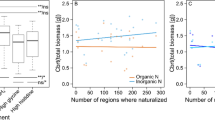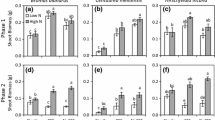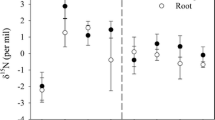Abstract
Plants differ in their capacity to use various forms of nitrogen (N). Although previous studies have suggested invasive plants alter N availability, few distinguish their responses to various forms and different concentrations of inorganic N. In order to understand how plant preference for N affects invasions, we tested the growth and physiological response of Flaveria bidentis, an invasive plant across north China, to different forms and concentrations of inorganic N. Seedlings of F. bidentis were cultivated in a mothproof screen house to determine if this invader benefits from increased or altered forms of N. 15N-labeled NH4 + and NO3 − were applied to the soil to gain insight into N partitioning in communities invaded by this species. We determined that plant growth and biomass variables, chlorophyll content, and photosynthesis parameters all varied depending on the form of available N. Specifically, N addition altered the biomass allocation pattern of plants, with F. bidentis tending to maximize its reproductive output under increased N availability. Also, F. bidentis had higher 15N–NH4 + recovery across biomass components than both co-occurring native plants, Amaranthus retroflexus and Eclipta prostrata. F. bidentis demonstrated a strong preference for ammonium (NH4 +) over nitrate (NO3 −) and captured at least twice the 15N–NH4 + as the native plants. By comparison, the two native species showed no preferences for the form of N. The greater above-ground biomass of F. bidentis contributed to its higher 15N recovery. We suggest that the ability of F. bidentis to respond rapidly to changes in the N pool, especially in ammonium, may confer a competitive advantage to this species over native species. Our results provide insight into how species-specific N preferences influence the ability of this species to invade a native community.





Similar content being viewed by others
References
Aanderud ZT, Bledsoe CS (2009) Preferences for 15N-ammonium, 15N-nitrate, and 15N-glycine differ among dominant exotic and subordinate native grasses from a California Oak woodland. Environ Exp Bot 65:205–209
Aanderud ZT, Bledsoe CS, Richards JH (2003) Contribution of relative growth rate to root foraging by annual and perennial grasses from California oak woodlands. Oecologia 136:424–430
Abbès C, Parent L, Karam A, Isfan D (1995) Effect of NH4 +: NO3 − ratios on growth and nitrogen uptake by onions. Plant Soil 171:289–296
Adair EC, Burke IC (2010) Plant phenology and life span influence soil pool dynamics: Bromus tectorum invasion of perennial C3–C4 grass communities. Plant Soil 335:255–269
Andersen KM, Turner BL (2013) Preferences or plasticity in nitrogen acquisition by understorey palms in a tropical montane forest. J Ecol 101:819–825
Arnold G (1992) Soil acidification as caused by the nitrogen uptake pattern of Scots pine (Pinus sylvestris). Plant Soil 142(1):41–51
Bardgett RD, Streeter TC, Bol R (2003) Soil microbes compete effectively with plants for organic-nitrogen inputs to temperate grasslands. Ecology 84:1277–1287
Bever JD, Dickie IA, Facelli E, Facelli JM, Klironomos J, Moora M, Rillig MC, Stock WD, Tibbett M, Zobel M (2010) Rooting theories of plant community ecology in microbial interactions. Trends Ecol Evol 25:468–478
Bleier JS, Jackson RD (2007) Manipulating the quantity, quality, and manner of C addition to reduce soil inorganic N and increase C3:C4 grass biomass. Restor Ecol 15:688–695
Blumenthal DM, Jordan NR, Russelle MP (2003) Soil carbon addition controls weeds and facilitates prairie restoration. Ecol Appl 13:605–615
Bobbink R, Hornung M, Roelofs JM (1998) The effects of airborne nitrogen pollutants on species diversity in natural and semi-natural European vegetation. J Ecol 86:717–738
Boudsocq S, Niboyet A, Lata JC, Raynaud X, Loeuille N, Mathieu J, Blouin M, Abbadie L, Barot S (2012) Plant preference for ammonium versus nitrate: a neglected determinant of ecosystem functioning? Am Nat 180:60–69
Brooks ML (2003) Effects of increased soil nitrogen on the dominance of alien annual plants in the Mojave Desert. J Appl Ecol 40:344–353
Callaway RM, Ridenour WM, Laboski T, Weir T, Vivanco JM (2005) Natural selection for resistance to the allelopathic effects of invasive plants. J Ecol 93:576–583
Christou M, Avramides EJ, Jones DL (2006) Dissolved organic nitrogen dynamics in a Mediterranean vineyard soil. Soil Biol Biochem 38:2265–2277
Claridge K, Franklin SB (2002) Compensation and plasticity in an invasive plant species. Biol Invasions 4:339–347
Corbin JD, D’Antonio CM (2004) Effects of exotic species on soil nitrogen cycling: implications for restoration. Weed Technol 18:1464–1467
Cui X, Song J (2007) Soil NH4 +/NO3 − nitrogen characteristics in primary forests and the adaptability of some coniferous species. Front For China 2(1):1–10
Daehler CC (2003) Performance comparisons of co-occurring native and alien invasive plants: implications for conservation and restoration. Annu Rev Ecol Evol Syst 34:183–211
Davis MA, Grime JP, Thompson K (2000) Fluctuating resources in plant communities: a general theory of invisibility. J Ecol 88:528–534
de Graaf MCC, Bobbink R, Roelofs JGM, Verbeek PJM (1998) Differential effects of ammonium and nitrate on three heathland species. Plant Ecol 135:185–196
DeMeester JE, Richter DD (2010) Differences in wetland nitrogen cycling between the invasive grass Microstegium vimineum and a diverse plant community. Ecol Appl 20:609–619
Ehleringer JR, Monson RK (1993) Evolutionary and ecological aspects of photosynthetic pathway variation. Annu Rev Ecol Syst 24:411–439
Ehrenfeld JG (2003) Effects of exotic plant invasions on soil nutrient cycling processes. Ecosystems 6:503–523
Ehrenfeld JG, Ravit B, Elgersma K (2005) Feedback in the plant–soil system. Annu Rev Environ Resour 30:75–115
Fraterrigo JM, Strickland MS, Keiser AD, Bradford MA (2011) Nitrogen uptake and preference in a forest understory following invasion by an exotic grass. Oecologia 167:781–791
Funk JL, Vitousek PM (2007) Resource-use efficiency and plant invasion in low-resource systems. Nature 446:1079–1081
Gao XM, Tang TG, Zheng LY, Zheng TX, Sang WG, Chen YL (2004) An alert regarding biological invasion by a new exotic plant, Flaveria bidentis, and strategies for its control. Chin Biodivers Sci 12:274–279
Gross KL, Mittelbach GG, Reynolds HL (2005) Grassland invasibility and diversity: responses to nutrients, seed input, and disturbance. Ecology 86:476–486
Gurevitch J, Howard TG, Ashton IW, Leger EA, Howe KM, Woo E, Lerdau M (2008) Effects of experimental manipulation of light and nutrients on establishment of seedlings of native and invasive woody species in Long Island, NY forests. Biol Invasions 10:821–831
Haubensak KA, Allcock KG, Mattingly WB, Swedo B, Young LM, Reynolds HL (2007) Carbon addition to soils as a tool for restoration and research: a meta-analysis of patterns and mechanisms. In: Joint conference of the Ecological Society of America and Society for Ecological Restoration International. https://eco.confex.com/eco/2007/techprogram/P6511.HTM. Accessed 21 Feb 2016
Hellmann C, Sutter R, Rascher KG, Maguas C, Correia O, Werner C (2011) Impact of an exotic N2-fixing Acacia on composition and N status of a native Mediterranean community. Acta Oecol Int J Ecol 37:43–50
Hewins DB, Hyatt LA (2010) Flexible N uptake and assimilation mechanisms may assist biological invasion by Alliaria petiolata. Biol Invasions 12(8):2639–2647
Hierro JL, Maron JL, Callaway RM (2005) A biogeographical approach to plant invasions: the importance of studying exotics in their introduced and native range. J Ecol 93:5–15
Hoffmann A, Milde S, Desel C, Hümpel A, Kaiser H, Hammes E, Piippo M, Soitamo A, Aro E, Gerendás J, Sattelmacher B, Hansen U (2007) N form-dependent growth retardation of Arabidopsis thaliana seedlings as revealed from physiological and microarray studies. J Plant Nutr Soil Sci 170:87–97
Hood R (2001) Evaluation of a new approach to the nitrogen-15 isotope dilution technique, to estimate crop N uptake from organic residues in the field. Biol Fertil Soils 34:156–161
Huangfu CH, Zhang TR, Chen DQ, Wang NN, Yang DL (2011) Residual effects of invasive weed Yellowtop (Flaveria bidentis) on forage plants for ecological restoration. Allelopathy J 27:55–64
Hunt HW, Ingham ER, Coleman DC, Elliott ET, Reid CPP (1988) Nitrogen limitation of production and decomposition in prairie, mountain meadow, and pine forest. Ecology 69:1009–1016
Imsande J, Edwards G (1988) Decreased rates of nitrate uptake during pod fill by cowpea green gram and soybean. Agron J 80:789–793
Imsande J, Touraine B (1994) N demand and the regulation of nitrate uptake. Plant Physiol 105:3–7
Jo I, Fridley JD, Frank DA (2016) More of the same? In situ leaf and root decomposition rates do not vary between 80 native and nonnative deciduous forest species. New Phytol 209:115–122
Jones DL, Healey JR, Willett VB, Farrar JF, Hodge A (2005) Dissolved organic nitrogen uptake by plants—an important N uptake pathway? Soil Biol Biochem 37:413–423
Kielland K (1994) Amino acid absorption by arctic plants: implications for plant nutrition and nitrogen cycling. Ecology 75:2373–2383
Lee M, Flory S, Phillips R (2012) Positive feedbacks to growth of an invasive grass through alteration of nitrogen cycling. Oecologia 170:1–9
Li SQ, Li SX, Yang ZL (2002) Constituent and amount of amino acid in different ecological system soils. Acta Ecol Sin 22:379–386
Liao CZ, Peng R, Luo Y, Zhou X, Wu X, Fang C, Chen J, Li B (2008) Altered ecosystem carbon and nitrogen cycles by plant invasion: a meta-analysis. New Phytol 177:706–714
Lichtenthaler HK (1987) Chlorophylls and carotenoids. Pigments of photosynthetic biomembranes. Methods Enzymol 148:350–382
Liu QR (2005) Flaveria Juss. (Compositae), a newly naturalized genus in China. Acta Phytotaxon Sin 43:178–180
Liu X, Duan L, Mo J, Du E, Shen J, Lu X, Zhang Y, Zhou X, He C, Zhang F (2011) Nitrogen deposition and its ecological impact in China: an overview. Environ Pollut 159(10):2251–2264
Lowe PN, Lauenroth WK, Burke IC (2003) Effects of nitrogen availability on competition between Bromus tectorum and Bouteloua gracilis. Plant Ecol 167:247–254
Ma JW, Geng SL, Wang SB, Zhang GL, Fu WD, Shu B (2011) Genetic diversity of the newly invasive weed Flaveria bidentis (Asteraceae) reveals consequences of its rapid range expansion in northern China. Weed Res 51(4):363–372
McKane RB, Johnson LC, Shaver GR, Nadelhoffer KJ, Rastetter EB, Giblin AE, Kielland K, Kwiatkowski BL, Laundre JA, Murray G (2002) Resource-based niches provide a basis for plant species diversity and dominance in arctic tundra. Nature 415:68–71
Olsson MO, Falkengren-Grerup U (2000) Potential nitrification as an indicator of preferential uptake of ammonium or nitrate by plants in an oak woodland understorey. Ann Bot 85:299–305
Ordonez A, Olff H (2013) Do alien plant species profit more from high resource supply than natives? A trait-based analysis. Glob Ecol Biogeogr 22:648–658
Owen AG, Jones DL (2001) Competition for amino acids between wheat roots and rhizosphere microorganisms and the role of amino acids in plant N acquisition. Soil Biol Biochem 33:651–657
Perry LG, Blumenthal DM, Monaco TA, Paschke MW, Redente EF (2010) Immobilizing nitrogen to control plant invasion. Oecologia 163:13–24
Pickart AJ, Miller LM, Duebendorfer TE (1998) Yellow bush lupine invasion in Northern California coastal dunes I. Ecological impacts and manual restoration techniques. Restor Ecol 6:59–68
Raab TK, Lipson DA, Monson RK (1999) Soil amino acid utilization among the Cyperaceae: plant and soil processes. Ecology 80:2408–2419
Reynolds HL, Packer A, Bever JD, Clay K (2003) Grassroots ecology: plant–microbe–soil interactions as drivers of plant community structure and dynamics. Ecology 84:2281–2291
Ross K, Ehrenfeld J, Patel M (2011) The effects of nitrogen addition on the growth of two exotic and two native forest understory plants. Biol Invasions 13(10):2203–2216
Rout ME, Chrzanowski TH (2009) The invasive Sorghum halepense harbors endophytic N2-fixing bacteria and alters soil biogeochemistry. Plant Soil 315:163–172
Shi W, Norton JM (2000) Effect of long-term, biennial, fall-applied anhydrous ammonia and nitrapyrin on soil nitrification. Soil Sci Soc Am J 64:228–234
Song MH, Zheng LL, Suding KN, Yin TF, Yu FH (2015) Plasticity in nitrogen form uptake and preference in response to long-term nitrogen fertilization. Plant Soil 394(1):215–224
Suding KN, LeJeune KD, Seastedt TR (2004) Competitive impacts and responses of an invasive weed: dependencies on nitrogen and phosphorus availability. Oecologia 141:526–535
Sun Y, Ding J, Ren M (2009) Effects of simulated herbivory and resource availability on the invasive plant, Alternanthera philoxeroides in different habitats. Biol Control 48:287–293
Tu CY, Huangfu CH, Jiang N, Wang NN, Chen DQ, Yang DL, Gao SB (2013) Carbon, nitrogen and phosphorus stoichiometric characteristics of Flaveria bidentis in different habitats. Chin Agric Sci Bull 29:171–176
Vilà M, Espinar JL, Hejda M, Hulme PE, Jarosik V, Maron JL, Pergl J, Schaffner U, SunY Pysek P (2011) Ecological impacts of invasive alien plants: a meta-analysis of their effects on species, communities and ecosystems. Ecol Lett 14:702–708
Vitousek PM, Farrington H (1997) Nutrient limitation and soil development: experimental test of a biogeochemical theory. Biogeochemistry 37:63–75
Vitousek PM, Walker LR (1989) Biological invasion by Myrica faya in Hawaii: plant demography, nitrogen fixation, ecosystem effects. Ecol Mongr 59:247–265
von Wirén N, Gazzarrini S, Gojon A, Frommer WB (2000) The molecular physiology of ammonim uptake and retrieval. Curr Opin Plant Biol 3:254–261
Wilson SD, Gerry AK (1995) Strategies for mixed-grass prairie restoration: herbicide, tilling, and nitrogen manipulation. Restor Ecol 3:290–298
Yelenik SG, Stock WD, Richardson DM (2004) Ecosystem level impacts of invasive Acacia saligna in the South African fynbos. Restor Ecol 12:44–51
Zhang TR, Huangfu CH, Bai XM, Yang DL (2010) Effects of Flaveria bidentis invasion on soil nutrient contents and enzyme activities. Chin J Ecol 29:1353–1358
Zhao XH, Yang DL, Wang H, Liu HM, Qu B, Huangfu CH (2015) Effects of Flaveria bidentis invasion on soil nitrogen cycling and soil microbial biomass in different regions. Acta Pratacultuae Sin 24:62–69
Acknowledgments
This work was funded by the Natural Science Foundation of Tianjin (12JCQNJC09800), the Special Fund for Agro-scientific Research in the Public Interest (200803022, 201103027), National Natural Science Foundation of China (No. 31401811) and National Key Research and Development Program (2016YFC1202200). This article is dedicated to the memory of my beloved sister, QY, Huangfu. Former master candidates from our lab, including NN, Wang and XH, Zhao, provided lab and common garden assistance. The authors would also like to thank three anonymous reviewers for providing excellent comments and critical suggestions that greatly improve this manuscript.
Author information
Authors and Affiliations
Corresponding author
Ethics declarations
Conflict of interest
The authors declare that they have no conflict of interest.
Electronic supplementary material
Below is the link to the electronic supplementary material.
Rights and permissions
About this article
Cite this article
Huangfu, C., Li, H., Chen, X. et al. Response of an invasive plant, Flaveria bidentis, to nitrogen addition: a test of form-preference uptake. Biol Invasions 18, 3365–3380 (2016). https://doi.org/10.1007/s10530-016-1231-1
Received:
Accepted:
Published:
Issue Date:
DOI: https://doi.org/10.1007/s10530-016-1231-1




